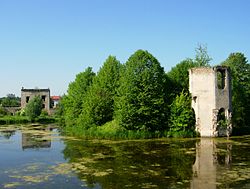Ćmielów
| Ćmielów | ||
|---|---|---|

Ruins of Ćmielów Castle
|
||
|
||
| Coordinates: 50°53′25″N 21°30′53″E / 50.89028°N 21.51472°E | ||
| Country |
|
|
| Voivodeship | Świętokrzyskie | |
| County | Ostrowiec | |
| Gmina | Ćmielów | |
| Area | ||
| • Total | 13.21 km2 (5.10 sq mi) | |
| Population (2006) | ||
| • Total | 3,172 | |
| • Density | 240/km2 (620/sq mi) | |
| Postal code | 27–440 | |
| Area code(s) | +48 41 | |
| Car plates | TOS | |
| Website | http://www.cmielow.pl/ | |
Ćmielów [ˈt͡ɕmʲɛluf] is a town in Ostrowiec County, Świętokrzyskie Voivodeship, Poland, seat of Gmina Ćmielów. It has 3,222 inhabitants (2004). It is known for one of Poland's oldest porcelain factories dating back to 1790. The town history dates back to 14th century. It has several tourist attractions, in addition to its old porcelain factory, including ruins of a 16th-century castle and a church from the same period. Ćmielów belongs to Lesser Poland, and lies on the Kamienna river in the Sandomierz Upland, 10 kilometers east of Ostrowiec Świętokrzyski, along local road nr. 755.
First mention of the village comes from the 14th century. In 1388, brothers Marcin and Mikołaj from Baruchów sold the village and the castle to knight Gniewosz of Dalewice. In 1425 Ćmielów was bought by Jan of Podłodów, then the village was acquired by the noble Szydłowiecki family. At that time what today is Ćmielów was divided into two villages - Ćmielów itself, located in the vicinity of the castle, and nearby Szydłów. Both villages were merged in 1505, when in Radom, King Alexander granted town charter to the town of Ćmielów. The new town remained in the hands of the Szydłowiecki family, which turned it into one of their residences. Chancellor Krzysztof Szydłowiecki invested in the castle, making it a Renaissance palace (1519-1531). In 1606, Ćmielów passed into the hands of the Ostrogski family.
Prosperity of the town came to an end during the Swedish invasion of Poland. On April 12, 1657, Swedish and Transylvanian armies met here, and the castle was the temporary residence of George II Rakoczi. United armies of the two powers destroyed most of Lesser Poland, together with Ćmielów. In the 18th century the town belonged to several families (Lubomirski family, Małachowski family, Pusłowski family), and in 1896 - to Prince Aleksander Drucki-Lubecki. Some time in the 18th century Ćmielów emerged as a center of pottery. In 1750, King Augustus III of Poland issued a privilege to local artisans, allowing them to sell their products across the country. The privilege was confirmed in 1768, and either in 1804 or 1809, Count Jacek Małachowski opened here a porcelain factory. Following other towns of northern Lesser Poland, Ćmielów, which after the Partitions of Poland belonged to Russian-controlled Congress Poland lost its town charter in 1869, as a punishment for the January Uprising. In 1915 it received a rail station, along a route from Skarżysko-Kamienna to Sandomierz.
...
Wikipedia


